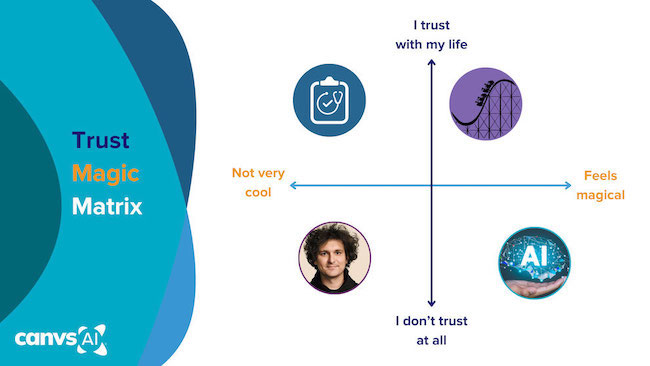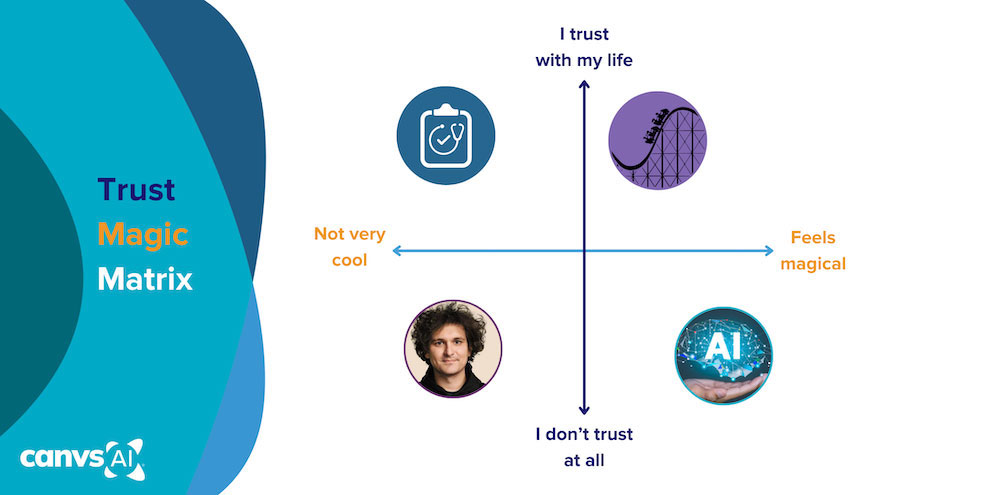How AI is supercharging storytelling and elevating insights
By Jared Feldman, Founder and CEO, Canvs AI
 While it may seem ironic, one of the biggest benefits of generative artificial intelligence for insights leaders may be in helping to better understand how consumers really feel and why.
While it may seem ironic, one of the biggest benefits of generative artificial intelligence for insights leaders may be in helping to better understand how consumers really feel and why.
Consumer empathy – deeply understanding customer emotions and perspectives – has become a strategic imperative. The preeminent behavioral economist Daniel Kahneman, author of “Thinking, Fast and Slow,” found that upwards of 90% of human decisions are guided by emotion over pure logic. Thus, understanding how people feel is crucial for influencing choice and behavior. For organizations looking to build empathy with customers and guide better decisions, capturing and analyzing emotional feedback is a strategic priority.
Yet at the very moment organizations need greater alignment with consumer emotions, they face a tidal wave of unstructured feedback that hides these insights in plain sight. By 2025, over 80% of customer feedback will be unstructured across sources like survey and community verbatims, chat logs, social posts and reviews. But analyzing emotion and meaning from text at scale has remained out of reach for most businesses. Most researchers found “traditional” text analysis solutions to be over-complex and under-accurate.
This problem is well-illustrated by one of the most “structured” forms of unstructured customer feedback: open-ended survey questions. Although these questions make up a small fraction of a typical survey, they offer a powerful platform for respondents to freely express their thoughts and feelings. Yet, despite their potential, even these responses are underutilized as a source of key insights due to the inefficiencies and inaccuracies inherent in text analysis.
Now, consider the vast ocean of customer feedback that exists outside of formal feedback channels such as consumer reviews, online chat logs, customer support interactions and social media comments. If the open-ends from surveys aren’t being analyzed, these sources don’t stand a chance. In a nutshell, organizations are lacking the essential tools to decode and utilize one of their most strategically valuable data sets.
This tension between the strategic need for consumer empathy and the operational challenge of extracting insights from text defines one of the most important opportunities for generative AI in the enterprise today. When grounded in real consumer data (the kind companies already have mountains of), generative AI can act as an empathy engine – revealing both the emotions and needs hidden within unstructured text.
Enter generative AI for consumer insights
It’s an understatement to say that AI has captured the current professional zeitgeist, and naturally has leaders in nearly every field thinking about the implications for their companies and work. Consumer insights and customer experience management are not immune. At first glance, generative AI may seem out of place in a discussion of text analysis (which implies understanding text that’s been written by humans), but current large language models (LLM) are nearly as good at comprehending as they are with generating (part of the magic of a ChatGPT is the natural language interface). Additionally, LLMs can be combined with AI-powered natural language processing (NLP) and sentiment analysis to help accelerate the understanding and organization of text. Finally, the popularization of generative AI has raised awareness about the importance and power of unstructured data analysis for business value.
The AI advantage: Turning feedback into foresight
It’s perhaps ironic that the business value of AI for insights is to enable human understanding by improving the way organizations understand consumer feedback. But understanding what’s being “said” in unstructured comments alone isn’t enough; organizations need multiple layers of analysis to put what’s being said into context. Context like the emotions being expressed around a topic or experience. Context like the differences between various segments of your audience (or sample). For example, what are the meaningful generational differences between how ad creative is consumed? Or perhaps what are the meaningful generational connections?
So how should insights leaders think about the tangible return on their AI insights investments? In working with hundreds of insights groups, we’ve identified three primary categories of financial value from AI technologies insights:
- Deeper insights and consumer empathy.
- Insights team productivity (i.e., time savings) and happiness.
- Data value enhancement.
Deeper insights and consumer empathy through text analysis
The saying goes that you miss 100% of the shots you don’t take, but you also miss 100% of the insights you don’t analyze. Because unstructured text has been challenging to analyze consistently at scale, many organizations aren’t using text to generate core insights, instead they are typically cherry-picking verbatims to add to reports. By lowering the complexity barrier while increasing accuracy and nuance, text can now be viewed as a primary source of insights. In fact, because open-ended responses provide a less restrictive form of feedback, research and CX teams can strategically incorporate more open-ended feedback and potentially reduce survey length and fatigue as a result.
Capturing emotion is another important benefit of AI-powered text analysis. Advanced AI can not only detect positive and negative emotions, but it can also identify and measure nuanced emotional feedback. The AI can determine that the respondent expressed positive feelings but also that the product evoked happy memories and nostalgia. This kind of nuanced emotion analysis is particularly valuable for creative and product testing.
The power of analyzing unstructured text really emerges when these lenses of analysis combine to reveal how consumers feel and why. As such, the insights discovery tools to empower the exploration of data are nearly as important as the analysis of the text itself.
Insights productivity and happiness
Any organization that’s “coded” the verbatims from a survey knows how time consuming and tedious this work can be. If not completed internally, the work is often outsourced to specialist shops, adding time and expense to research cycles. Naturally, this approach isn’t even feasible for very large-scale data sets like product reviews and NPS/CSAT studies that generate thousands or even tens of thousands of responses on an ongoing basis. Given this backdrop, the productivity gains from automating the analysis of open-ended text are likely obvious. Users of Canvs, for example, report reducing human work time from weeks to just an hour. But perhaps more importantly, automation tools get your most valuable asset – your people – out of the weeds of reading verbatims and into higher-level analysis of what the text means and what to do about it. The quality of life improvement from this alone can be significant!
As AI text analysis becomes integrated into the research and/or CX technology stack, previously unstructured text data can be structured into topics, themes and emotions and operate as a “first-class” data citizen for further analysis, like demographic crosstabs or observing trends over time (via longitudinal tracking studies, etc.). This is where AI starts to impact the value of the underlying data set.
Data value
Data has long been called the “new oil” of our modern economy. This analogy is primarily meant to convey that data fuels the engine of decision-making and value creation (the way the “old oil” turned the gears of the mechanical age). But to take the analogy a bit further, AI helps make data a more productive asset by maximizing both access and the decisioning power of data. We’ve already touched on the access issue of unstructured text, where AI expands the available use cases by reducing complexity and time from analysis. But AI, particularly generative AI, is also helping organizations use that data more effectively by providing an intuitive, natural-language interface. AI is supercharging data fuel efficiency.
In practical terms, insights and CX organizations can do more with their consumer feedback, extracting the maximum insights value possible. For example, you can distill the nuance of how customers describe a particular experience or product, ask for structured recommendations from the AI or even generate buyer personas and new product ideas. You’ve suddenly turned a data set of unstructured text comments into an interactive customer panel combined with a research analyst.
But what about hallucinations?
 As “Ethical Machines” author Reid Blackman notes in a recent Harvard Business Review article on generative AI, hallucinations are a significant impediment to trust and ultimately the adoption of generative AI in any business-critical context. As a naturally skeptical and evidence-based cohort, insights professionals are rightly cautious of putting their faith in AI-generated insights. A mental model for thinking about this trade-off is what we’ve coined as the Trust-Magic Matrix. The horizontal axis runs from “not magical at all” to “full-of-wonder level magic,” while the vertical axis spans from “don’t trust at all” to “trust with my life.” Most applications of generative AI sit at the bottom right quadrant of the matrix; it feels magical but we’re not quite ready to trust it with our lives. The job of smart applications of AI may be to find ways to build trust into the systems despite the inherent limitations of LLMs.
As “Ethical Machines” author Reid Blackman notes in a recent Harvard Business Review article on generative AI, hallucinations are a significant impediment to trust and ultimately the adoption of generative AI in any business-critical context. As a naturally skeptical and evidence-based cohort, insights professionals are rightly cautious of putting their faith in AI-generated insights. A mental model for thinking about this trade-off is what we’ve coined as the Trust-Magic Matrix. The horizontal axis runs from “not magical at all” to “full-of-wonder level magic,” while the vertical axis spans from “don’t trust at all” to “trust with my life.” Most applications of generative AI sit at the bottom right quadrant of the matrix; it feels magical but we’re not quite ready to trust it with our lives. The job of smart applications of AI may be to find ways to build trust into the systems despite the inherent limitations of LLMs.
At Canvs AI, we’ve been applying AI to the challenges of understanding modern language for many years and have taken the approach of providing full transparency into the specific verbatims being analyzed, taking a trust-through-verification approach. Additionally, restricting analysis to just the data you bring into the system provides another layer of safeguard. We’ve found that providing the ability to customize the system through rules allows researchers to guide the analysis in partnership with the AI. We believe ultimately that the benefits of AI automation for text analysis significantly outweigh the drawbacks, particularly when some thoughtful data validation and citations can be incorporated.
The future of insights: Empathy elevated
As we move towards a future dominated by unstructured feedback, AI's role in turning this feedback into valuable insights will become increasingly crucial. Understanding the 80% of consumer feedback that is unstructured unlocks organizations’ abilities to achieve consumer empathy. By unlocking the true potential of consumer feedback, businesses can become more customer-centric, responsive and ultimately successful.

